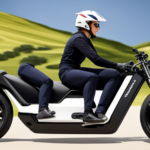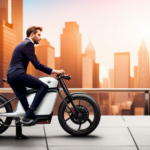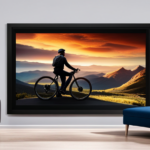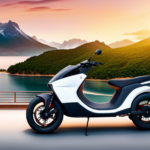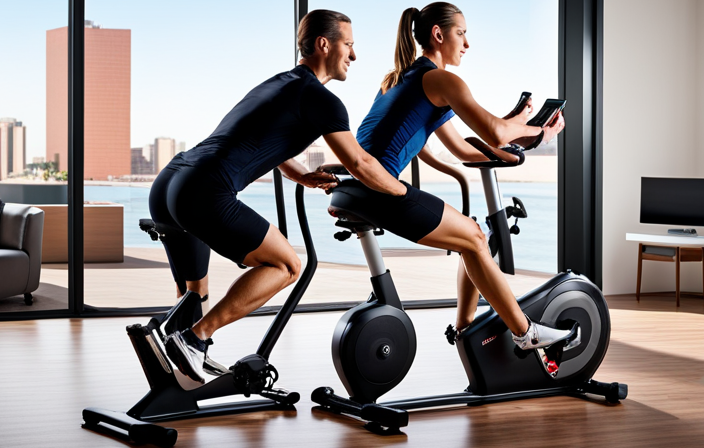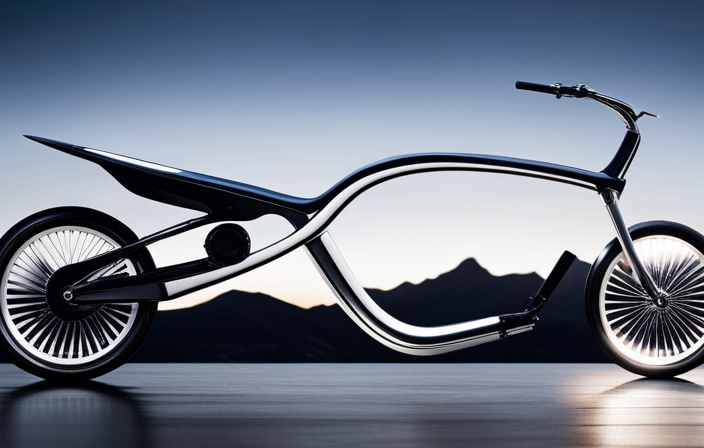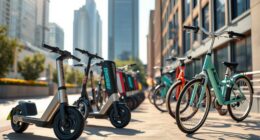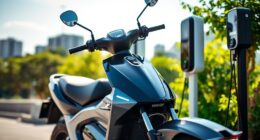Did you know that the average electric bike can cover a distance of up to 50 miles on a single charge? That’s an impressive range that can take you on exciting adventures without worrying about running out of battery.
In this article, I will delve into the factors that determine how long you can ride an electric bike, such as battery capacity, riding conditions, and your own weight and fitness level.
Get ready to maximize your e-bike experience and explore new horizons.
Key Takeaways
- Battery capacity and charging time determine the range of an electric bike.
- Pedal-assist bikes extend battery life and offer a natural riding experience, while throttle-controlled bikes provide instant acceleration but drain the battery faster.
- Terrain and riding conditions, such as uphill challenges and off-road trails, can impact battery life.
- Rider’s weight and fitness level, as well as riding style and speed, also affect the range of an electric bike.
Understanding the Battery Capacity
The battery capacity determines how long you can ride an electric bike. It is essentially the amount of energy that the battery can store, which directly impacts the battery life. The higher the battery capacity, the longer you can ride before needing to recharge.
Charging duration is another important factor to consider. Some batteries can be fully charged in just a few hours, while others may take longer. It’s important to know the charging time of your battery so that you can plan your rides accordingly.
Now, let’s move on to the next section where we will discuss the difference between pedal-assist and throttle-controlled bikes.
Pedal-Assist vs. Throttle-Controlled Bikes
When it comes to pedal-assist vs. throttle-controlled bikes, you can go for a ride. These two types of electric bikes offer different ways to experience the thrill of riding.
With pedal-assist bikes, the motor provides assistance as you pedal, making it feel like you have supercharged legs. This not only extends the battery life but also allows for a more natural and intuitive riding experience.
On the other hand, throttle-controlled bikes let you control the speed with a twist of the throttle, similar to a motorcycle. While this offers instant acceleration and requires less effort, it can drain the battery faster due to the constant use of the motor. Therefore, it’s important to consider the battery life comparison and motor power efficiency when choosing between the two.
Speaking of which, terrain and riding conditions play a crucial role in determining how long you can ride an electric bike.
Terrain and Riding Conditions
To get the most out of your e-bike, consider the type of terrain and riding conditions you’ll be facing. This will help you optimize your battery life and range. Here are three important factors to keep in mind:
-
Uphill Challenges: Riding on steep inclines requires more power from the motor, draining the battery faster. Make sure your e-bike has enough torque to handle uphill climbs effectively.
-
Off-Road Adventures: If you enjoy off-road trails or rough terrains, opt for an e-bike with a robust suspension system. This will provide a smoother ride and reduce the impact on your battery.
-
City Commutes: Riding in urban areas with frequent stops and starts can drain your battery quickly. Consider a pedal-assist e-bike that allows you to contribute to the power and extend your range.
Considering these terrain and riding conditions will help you optimize your e-bike’s battery life and range.
Moving on to the next section, let’s discuss how your weight and fitness level can impact your ride.
Rider’s Weight and Fitness Level
When it comes to electric bikes, understanding how rider weight affects range is crucial. The heavier the rider, the more power the motor needs to exert, which can decrease the overall range of the bike.
Additionally, fitness level plays a role in the amount of pedaling assistance needed. A rider who is less fit may rely more on the motor, while a fitter rider may require less assistance.
To maximize range based on weight and fitness level, it’s important to find a balance between using the motor and pedaling, and to consider choosing a higher capacity battery if necessary.
How rider weight affects range
Rider weight significantly affects the range of an electric bike. The battery capacity of an electric bike determines how far it can go on a single charge. Heavier riders put more strain on the battery, causing it to drain faster and reducing the overall range.
Additionally, the terrain plays a crucial role in determining the range. Uphill climbs require more power from the motor, which in turn drains the battery at a faster rate. On the other hand, riding on flat terrain or downhill requires less power, allowing the battery to last longer.
It’s important to consider these factors when choosing an electric bike, as a heavier rider or hilly terrain may require a bike with a larger battery capacity.
Moving on to the next topic, a rider’s fitness level and the amount of pedaling assistance needed can also impact the range of an electric bike.
Fitness level and the amount of pedaling assistance needed
Your fitness level and how much assistance you need while pedaling can impact the range of an e-bike. When it comes to battery life and energy consumption, the more you rely on the motor for assistance, the quicker the battery will drain. If you have a lower fitness level and require more assistance, you may find that your e-bike’s range is reduced. This is because the motor consumes more energy to provide the necessary assistance.
On the other hand, if you have a higher fitness level and require less assistance, you can expect a longer range as the motor consumes less energy. To maximize your range based on weight and fitness level, there are some tips to keep in mind.
[Transition into the subsequent section about ‘tips for maximizing range based on weight and fitness level’.]Tips for maximizing range based on weight and fitness level
To get the most out of your e-bike’s range, it’s helpful to consider your weight and fitness level. Your weight plays a significant role in determining how far your electric bike can take you. The heavier you are, the more strain you put on the battery, which can result in reduced range. Therefore, it’s important to maintain a healthy weight to maximize your e-bike’s range.
Additionally, your fitness level affects the amount of pedaling assistance needed. If you’re in good shape, you can pedal more and rely less on the motor, which can help conserve battery power.
When it comes to battery maintenance, make sure to follow the manufacturer’s guidelines for charging methods. Properly charging your e-bike’s battery will not only extend its lifespan but also ensure optimal performance.
By considering your weight, fitness level, and following proper battery maintenance, you can make the most of your e-bike’s range.
Now let’s delve into the next section about riding style and speed.
Riding Style and Speed
When it comes to riding an electric bike, your riding style and speed can have a significant impact on the range you can achieve.
Riding at higher speeds can decrease your range, as the motor has to work harder to maintain that speed.
Additionally, frequent starts and stops can also decrease your range, as each time you stop and start again, the motor has to work harder to get you back up to speed.
To optimize your riding style and increase your range, it is best to maintain a consistent speed and avoid unnecessary stops and starts.
Additionally, using pedal-assist mode can help conserve battery power and extend your range even further.
Impact of riding at higher speeds on range
If you ride an electric bike at higher speeds, you’ll notice a decrease in your overall range. This is because riding at higher speeds consumes more battery power, resulting in reduced battery efficiency. When you ride faster, the motor needs to work harder to maintain the speed, which uses up more energy from the battery.
Additionally, the impact of wind resistance becomes more significant as you increase your speed. The faster you go, the greater the resistance you encounter, which further drains the battery. It’s essential to keep in mind that riding at higher speeds can significantly affect your electric bike’s range.
Moving on to the next section about how frequent starts and stops affect range, it’s important to consider how these actions can impact the overall efficiency of your electric bike.
How frequent starts and stops affect range
Frequent starts and stops can have an impact on the overall range of an e-bike. When you constantly accelerate and brake, it puts a strain on the battery, causing it to drain faster. The more often you start and stop, the more energy is wasted, resulting in a shorter battery range.
Additionally, the constant acceleration and deceleration require more power from the motor, which further reduces the range. To maximize your battery range, it is important to minimize the number of starts and stops during your ride. Instead, try to maintain a steady pace and anticipate traffic flow to avoid unnecessary braking.
By doing so, you can extend the distance you can ride on a single charge and reduce the frequency of charging.
Now let’s delve into some tips to optimize your riding style and increase your e-bike’s range.
Tips for optimizing riding style to increase range
When it comes to maximizing the range of an electric bike, it’s not just about the bike itself, but also about the way you ride it. One of the key factors in increasing range is optimizing your riding style. By implementing some simple techniques, you can conserve energy and extend the life of your battery.
One important aspect is maintaining a steady pace and avoiding frequent starts and stops, as mentioned in the previous section. Additionally, there are other energy-saving techniques you can employ, such as using lower levels of assistance when pedaling, avoiding excessive use of throttle, and taking advantage of regenerative braking whenever possible. These practices not only save energy but also contribute to a smoother and more enjoyable ride.
Now that we’ve covered optimizing riding style, let’s move on to the next section about bike maintenance and efficiency.
Bike Maintenance and Efficiency
You can maximize your electric bike’s efficiency through regular maintenance. Here are three key aspects to consider for bike maintenance and efficiency:
-
Battery Maintenance: Ensure your battery is in good condition by keeping it clean and free of debris. Regularly check for any signs of damage or wear, such as cracked casing or loose connections. It’s also important to charge your battery properly, following the manufacturer’s guidelines, to maintain its performance and longevity.
-
Increasing Efficiency: Keep your tires properly inflated to reduce rolling resistance and improve efficiency. Regularly clean and lubricate the chain to minimize friction and ensure smooth pedaling. Adjust your bike’s gears and brakes to optimize performance and reduce energy consumption.
-
Regular Check-ups: Schedule routine check-ups with a qualified technician to inspect your bike’s components and ensure everything is functioning optimally. They can identify any potential issues before they become major problems, saving you time and money in the long run.
By maintaining your electric bike effectively, you can maximize its efficiency and extend its battery life.
Transitioning into the subsequent section about ‘battery management and charging’, it’s also crucial to understand the importance of proper battery management and charging techniques.
Battery Management and Charging
When it comes to electric bike battery management, there are a few key tips to keep in mind in order to prolong the life of your battery.
It’s important to avoid overcharging or fully draining the battery, as this can lead to decreased performance over time.
Additionally, understanding the charging times and methods specific to your bike model is crucial for efficient charging.
Lastly, planning your rides based on battery life and available charging options can help ensure you always have enough power to get where you need to go.
Tips for proper battery management to prolong battery life
To prolong the battery life of your electric bike, it’s important to follow proper battery management tips. Here are some key tips to help you understand battery maintenance and maximize battery efficiency:
- Always charge your battery fully before using your electric bike.
- Avoid leaving your battery fully discharged for extended periods of time.
- Store your battery in a cool and dry place when not in use.
- Regularly clean the battery contacts and ensure they are free from dirt and debris.
Understanding these battery management tips will not only help prolong the battery life of your electric bike but also ensure optimal performance.
Now, let’s delve into understanding charging times and methods, which is crucial for maintaining a healthy battery and maximizing your riding experience.
Understanding charging times and methods
To ensure the longevity of your electric bike’s battery, it’s crucial to manage its charging properly. In the previous section, I provided some helpful tips for maximizing battery life. Now, let’s delve into understanding charging times and methods, which are equally important for maintaining your electric bike’s battery health.
When it comes to charging, it’s essential to know the various charging methods available. These methods include standard charging, fast charging, and trickle charging. Each method has its own charging time and impact on battery life. To help you visualize this information, here is a table outlining the different charging methods and their corresponding charging times:
| Charging Method | Charging Time |
|---|---|
| Standard Charging | 4-6 hours |
| Fast Charging | 1-2 hours |
| Trickle Charging | 10-12 hours |
Understanding these charging times can assist you in planning your rides based on battery life and available charging options. So, let’s move on to the next section and explore how to make the most of your electric bike’s battery and available charging options.
How to plan your rides based on battery life and charging options
To effectively plan your rides, take into consideration your battery life and available charging options. Route optimization is key to maximizing your battery life and getting the most out of your electric bike. By planning your route to avoid steep hills and opting for smoother terrain, you can conserve battery power and extend your ride.
Additionally, consider the distance of your ride and the estimated battery life of your bike. This will help you determine if you need to charge during your ride or if you can make it to your destination and back without needing to recharge. Battery maintenance is also important to ensure optimal performance. Regularly check the charge level, clean the contacts, and store the battery properly when not in use.
By following these tips, you can plan your rides effectively and make the most of your electric bike’s battery life.
Looking ahead to the next section about riding with a second battery, having a backup power source can provide peace of mind and allow for longer rides.
Riding with a Second Battery
When it comes to riding with a second battery on an electric bike, there are several benefits to consider.
First and foremost, having a spare battery allows for longer rides without the worry of running out of power.
Additionally, it provides peace of mind knowing that if one battery dies, there is a backup ready to go.
When choosing a second battery, factors such as capacity, weight, and compatibility with the bike should be taken into account.
To switch and charge batteries during longer rides, it is important to have a battery swapping system in place and to plan ahead for charging opportunities along the route.
Benefits of carrying a spare battery
You can ride an electric bike for a longer distance by carrying a spare battery. This is especially useful when you need to go on longer trips or when you want to explore different areas without worrying about running out of power.
Having a second battery gives you the flexibility to extend your ride and enjoy the benefits of electric biking for a longer period of time. It also provides you with range extender options, allowing you to go even further than before.
Additionally, riding in different weather conditions can affect the range of your electric bike. Carrying a spare battery ensures that you will have enough power to overcome any weather-related challenges.
When choosing a second battery, there are several factors to consider, such as battery capacity, weight, and compatibility with your electric bike. Transitioning into the next section about factors to consider when choosing a second battery, it is important to make an informed decision to maximize your riding experience.
Factors to consider when choosing a second battery
When it comes to carrying a spare battery for your electric bike, the benefits are undeniable. Not only does it provide peace of mind knowing you have a backup power source, but it also extends your riding range. However, choosing the right second battery requires careful consideration of various factors. One crucial factor is battery capacity, which determines how long you can ride before needing to recharge. It’s important to choose a second battery with sufficient capacity to meet your riding needs. Additionally, range optimization is another important aspect to consider. Look for batteries that offer efficient power usage and consider factors like terrain and riding style to ensure you get the most out of your battery’s range. By selecting the right second battery, you can enjoy extended rides on your electric bike without worrying about running out of power. Now let’s explore how to switch and charge batteries during longer rides.
How to switch and charge batteries during longer rides
Switching and charging batteries during extended rides is an essential skill for maximizing your electric bike’s range. It allows you to continue your journey without worrying about running out of power. Here are three key tips for effectively switching and charging batteries during longer rides:
-
Plan your route: Before setting out, research places along your route where you can stop and charge your batteries. Look for cafes, rest stops, or charging stations that offer convenient access to power outlets.
-
Carry extra batteries: Having an extra battery or two can significantly extend your riding distance. Make sure to choose batteries that are compatible with your electric bike and are lightweight and easy to carry.
-
Time your battery swaps: Switching batteries during breaks, such as when you stop for a meal or take a rest, is a smart strategy. This way, you can utilize your downtime to charge the depleted battery while enjoying a break.
By mastering the art of switching and charging batteries, you can confidently embark on longer rides knowing that you have the power to keep going.
Now, let’s explore some range extender options for further enhancing your electric bike’s capabilities.
Range Extender Options
If you’re looking to extend the range of your electric bike, there are various options available. One option is to invest in a range extender, which can help you go the extra mile. A range extender is an additional battery pack that can be easily attached to your electric bike. It provides extra power and extends the battery range, allowing you to ride for longer distances without worrying about running out of battery. Another option is to utilize alternative charging methods, such as solar panels or portable power banks, which can be handy when you’re on the go and don’t have access to a traditional power outlet. These methods can help you charge your batteries during longer rides, ensuring you have enough power to reach your destination. Transitioning into the next section about riding in different weather conditions, it’s important to consider how weather can affect the range and performance of your electric bike.
Riding in Different Weather Conditions
When it comes to riding an electric bike in different weather conditions, there are a few key points to consider.
Extreme temperatures can greatly affect battery performance, causing it to drain faster in the cold and overheat in the heat. To maintain range in hot and cold weather, it’s important to take precautions such as keeping the battery insulated or cooled, and avoiding long rides in extreme temperatures.
Additionally, riding in the rain or wet conditions can also impact range, as water can damage the electrical components of the bike. It’s important to take extra care in these conditions and consider waterproof accessories or finding alternative routes to avoid puddles and wet surfaces.
How extreme temperatures affect battery performance
Extreme temperatures can negatively impact the performance of an electric bike’s battery. Battery longevity can be significantly affected by extreme hot or cold weather conditions. Here are some key ways in which extreme temperatures can impact battery life:
- High temperatures can cause the battery to overheat, leading to a decrease in its overall capacity and efficiency.
- On the other hand, extremely cold temperatures can cause the battery to lose its charge more quickly, resulting in reduced range and performance.
- Rapid temperature changes, such as going from extreme heat to extreme cold or vice versa, can also put stress on the battery and affect its long-term durability.
Understanding the impact of extreme temperatures on battery life is crucial for electric bike riders. In the next section, I will provide tips for riding in hot and cold weather to maintain range and optimize battery performance.
Tips for riding in hot and cold weather to maintain range
For optimal range in hot and cold weather, it’s important to follow these tips while riding. First, ensure proper battery maintenance by keeping it charged and storing it in a cool, dry place when not in use. Extreme temperatures can affect battery performance, so avoid exposing your electric bike to direct sunlight or freezing temperatures for extended periods. Secondly, optimize your range by adjusting your riding style and speed. Riding at a moderate pace and avoiding sudden acceleration or braking can help conserve battery power. Additionally, dress appropriately for the weather, wearing layers in cold temperatures and using sunscreen in hot temperatures to stay comfortable. By following these tips, you can maximize your electric bike’s range and enjoy a smooth ride. Speaking of weather conditions, let’s now discuss the impact of rain and wet conditions on range.
Impact of rain and wet conditions on range
Rain and wet conditions can affect the range of an electric bike. When the weather is wet, the tires of the bike can have less grip on the road, which can result in increased rolling resistance. This increased resistance requires the motor to work harder, draining the battery faster and reducing the overall range.
To maintain battery performance in wet conditions, it is important to keep the bike’s tires properly inflated and ensure that the brakes are not dragging. Additionally, regularly cleaning and lubricating the bike’s chain and other moving parts can help to prevent rust and corrosion, which can also impact battery performance.
By following these maintenance tips, riders can help to ensure that their electric bike performs optimally in rainy and wet conditions.
Looking ahead, planning your routes can also be a key factor in maximizing range and overall riding experience.
Planning Your Routes
When it comes to maximizing range on my electric bike, route planning is key. By taking the time to plan my routes in advance, I can ensure that I am taking the most efficient path and avoiding unnecessary detours or uphill climbs that can drain my battery.
To find charging stations along my route, I rely on online maps and apps specifically designed for electric bike users, which provide real-time information on available charging stations nearby.
Additionally, I always consider factors such as traffic congestion and road conditions when choosing a route, as these can greatly impact my battery efficiency.
Importance of route planning for maximizing range
To maximize your range, it’s crucial to plan your route carefully when riding an electric bike. By considering battery management techniques and optimizing charging schedules, you can ensure that your electric bike lasts for a longer distance.
Here are some tips to help you plan your route effectively:
- Choose routes with fewer inclines to minimize energy consumption.
- Avoid routes with heavy traffic to maintain a steady speed.
- Look for routes that offer shade to prevent overheating of the battery.
- Consider using bike lanes or dedicated cycling paths to avoid obstacles and reduce the risk of accidents.
By following these route planning strategies, you can make the most of your electric bike’s range.
Now, let’s explore how to find charging stations along your route.
How to find charging stations along your route
Finding charging stations along your route is essential for ensuring a smooth journey on your electric bike. To find charging stations, you can use various resources such as electric bike apps, online maps, or even ask local bike shops for recommendations. These tools will provide you with a list of charging stations in your area, allowing you to plan your route accordingly.
Additionally, it’s important to consider alternative charging options, such as coffee shops or restaurants that offer charging facilities. This way, you can enjoy a meal or a quick break while your bike charges.
By finding charging stations and considering alternative options, you can eliminate any range anxiety and enjoy your ride without worrying about running out of battery power.
Now, let’s move on to some tips for choosing efficient routes to conserve battery power.
Tips for choosing efficient routes to conserve battery power
One helpful tip is to plan your route strategically to save battery power. This can be done by finding alternative charging options along your route. Look for places like coffee shops, restaurants, or public buildings that offer charging stations for electric bikes. By incorporating these stops into your route, you can ensure that you have access to a charger when needed.
Another tip is to take advantage of the benefits of regenerative braking. This feature allows your electric bike to recharge the battery while you ride by converting the energy from braking into electricity. By utilizing regenerative braking techniques, you can extend the range of your electric bike.
Understanding range estimates is the next step in maximizing your battery power and ensuring a longer ride.
Understanding Range Estimates
When it comes to understanding range estimates for electric bikes, manufacturers determine and advertise these estimates based on various factors such as battery capacity, motor power, and the level of assistance provided.
However, it’s important to keep in mind that real-world factors can impact the actual range you’ll get. Things like terrain, rider weight, wind resistance, and even tire pressure can all affect how far an electric bike can go on a single charge.
To manage and interpret range expectations, it’s helpful to consider these factors and also to ride in an efficient manner by using lower assistance levels when possible and maintaining a steady speed.
How manufacturers determine and advertise range estimates
Manufacturers determine and advertise range estimates based on various factors. Here are three key considerations for battery range estimation:
-
Battery capacity: The size and quality of the battery directly affect the estimated range. Higher capacity batteries typically provide a longer range before recharging is required.
-
Riding conditions: Manufacturers consider factors like terrain, speed, and rider weight when estimating range. Uphill rides, higher speeds, and heavier riders can all impact the battery’s performance.
-
Battery age: As the battery ages, its capacity decreases, leading to a shorter range. Manufacturers take this into account by providing an estimated range based on a new battery, but it’s important to keep in mind that actual range may vary over time.
Understanding these factors helps consumers make informed decisions about electric bikes.
Now, let’s explore the real-world factors that can affect the actual range without taking another step.
Real-world factors that can affect the actual range
Keep in mind that various real-world factors can impact the actual range of an e-bike.
One important factor to consider is battery maintenance. Properly maintaining your e-bike’s battery can help ensure optimal performance and maximize its range. Regularly checking the battery’s charge level, keeping it clean and dry, and charging it according to the manufacturer’s instructions are all essential for maintaining its longevity.
Another factor that can affect the range is the impact of wind. Riding against a strong headwind can significantly reduce the distance you can travel on a single charge, while riding with a tailwind can extend your range. It’s important to be aware of these factors and adjust your expectations accordingly.
Understanding how real-world factors can influence range will help you manage your e-bike’s performance effectively. Now let’s explore some tips for interpreting and managing range expectations.
Tips for interpreting and managing range expectations
When it comes to electric bikes, understanding battery range and managing your expectations is crucial. There are several factors that can affect the actual range of your electric bike, as discussed in the previous subtopic. However, there are tips that can help you interpret and manage your range expectations effectively. To assist you, I have created a table below outlining these tips:
| Tips for Interpreting and Managing Range Expectations |
|---|
| 1. Familiarize yourself with the bike’s advertised range and understand that real-world conditions may vary. |
| 2. Take into account factors such as terrain, wind, rider weight, and mode of assistance. |
| 3. Plan your routes accordingly, considering charging stations and possible detours. |
| 4. Monitor your battery level and adjust your riding style if needed. |
By following these tips, you can make the most of your electric bike’s battery range. Now, let’s explore how to maximize range on your commutes without compromising efficiency.
Maximizing Range on Commutes
To get the most out of your electric bike’s battery on your daily commute, try maintaining a steady speed and avoiding sudden acceleration or braking.
When riding in hilly areas, it’s important to be mindful of how it can impact your bike’s range. Uphill sections require more power, which can drain the battery faster. On the other hand, going downhill can actually help conserve energy as the bike’s motor can recharge the battery.
Another factor to consider is the impact of wind on your bike’s range. Riding against a strong headwind can significantly reduce the distance you can travel on a single charge. To maximize your range, try to ride in sheltered areas or use buildings and trees as windbreaks.
By being mindful of these factors, you can make the most of your electric bike’s battery during your daily commutes. As we move on to the next section about riding in eco mode and power settings, let’s explore how these settings can further optimize your bike’s range.
Riding in Eco Mode and Power Settings
When it comes to maximizing range on my electric bike, I’ve found that the power settings play a crucial role. By adjusting the power settings, I can significantly affect the distance I can ride on a single charge.
Riding in eco mode, for instance, can provide me with a longer range, as it conserves battery power by reducing the motor assistance. However, it’s important to note that there are limitations to riding in eco mode, such as decreased speed and less assistance on steep hills.
To maximize my range, I’ve learned to find a balance by adjusting the power settings based on the terrain and my energy level, ensuring I get the most out of my electric bike.
Effects of different power settings on range
The range of an electric bike can vary depending on the power setting chosen. Higher power settings consume more energy and can reduce the range of the bike. Riding on hilly or uneven terrains requires more power and can decrease the range. Aggressive acceleration and frequent use of the motor can drain the battery faster. The amount of support provided by the motor affects the energy consumption and subsequently the range.
Considering these factors, it is important to choose the right power setting to optimize your electric bike’s range. Now, let’s explore the benefits and limitations of riding in eco mode.
Benefits and limitations of riding in eco mode
One advantage of using eco mode is that it can extend your battery life. Eco mode is designed to optimize battery efficiency by reducing the power output of the electric motor. This means that you can ride for longer distances before needing to recharge.
Additionally, riding in eco mode can have a positive impact on your range, especially when you encounter hilly or challenging terrain. By reducing the power output, the motor is able to conserve energy and provide a more consistent and balanced ride. However, it’s important to note that riding in eco mode may result in a slightly slower speed compared to higher power settings.
Nonetheless, the benefits of extended battery life and improved range make eco mode a valuable option for electric bike riders. When it comes to maximizing range, there are a few tips for adjusting power settings that can further enhance your riding experience.
Tips for adjusting power settings to maximize range
To get the most out of your e-bike’s battery, try adjusting the power settings to maximize your range. Maximizing efficiency is key when it comes to extending the distance you can ride on a single charge. Here are three tips for adjusting power modes to maximize efficiency:
-
Start in eco mode: This power setting provides the least amount of assistance, but it also consumes the least amount of energy. By starting in eco mode, you can conserve battery power for when you really need it.
-
Gradually increase power: As you ride, gradually increase the power mode to a higher setting when you encounter inclines or headwinds. This way, you can utilize the assistance of the e-bike without draining the battery too quickly.
-
Use pedal assist wisely: Rather than relying solely on throttle mode, utilize the pedal assist feature. This not only helps you get more exercise, but it also maximizes the efficiency of the battery.
By adjusting power settings to maximize efficiency, you can extend the range of your e-bike.
In the next section, we will discuss additional tips for extending range on long-distance rides.
Tips for Extending Range on Long-Distance Rides
If you’re looking to extend the range on long-distance rides, there are a few tips you can follow.
First and foremost, maximizing battery life is crucial. One way to do this is by conserving energy during uphill climbs. When facing a steep incline, it’s important to use the appropriate power setting. Opt for a lower level of assistance to conserve energy and prevent draining the battery too quickly.
Additionally, maintaining a steady and consistent pace can help conserve energy and extend your range. Avoid sudden accelerations or decelerations, as these can drain the battery faster.
Another tip is to plan your route carefully, avoiding unnecessary detours or hilly terrains whenever possible.
By following these tips, you can make the most out of your electric bike’s range on long-distance rides.
Frequently Asked Questions
Are electric bikes suitable for all ages and fitness levels?
Electric bikes are suitable for all ages and fitness levels. They offer a great solution for commuting and provide numerous health benefits. Whether you’re young or old, fit or not, electric bikes can be enjoyed by everyone.
Can electric bikes be used for off-road trails and mountain biking?
To find the truth, I investigated whether electric bikes can handle off-road trails and mountain biking. To ensure a smooth ride, proper electric bike maintenance is crucial, as is choosing the right electric bike for these challenging terrains.
How long does it take to charge an electric bike battery fully?
It typically takes about 4-6 hours to fully charge an electric bike battery. The charging time may vary depending on the specific model and battery capacity. It’s important to note that the battery life can vary depending on factors such as terrain, rider weight, and assist level used.
Is it possible to ride an electric bike without any pedal assistance?
Yes, it is possible to ride an electric bike without any pedal assistance. However, utilizing pedal assistance offers numerous benefits such as increased range, improved exercise, and the ability to tackle challenging terrains more easily using different riding techniques.
Can electric bikes be ridden in heavy rain or snow?
Electric bikes can be ridden in heavy rain or snow, but there are pros and cons. The bike’s electrical components may be affected, but with proper maintenance and protection, riding in extreme weather conditions can still be possible and enjoyable.
Conclusion
In conclusion, riding an electric bike offers a world of possibilities. With the right understanding of battery capacity, choosing the right bike model, and considering terrain and riding conditions, riders can maximize the range of their electric bike. Taking into account factors such as rider’s weight and fitness level, riding style, and speed also plays a role in extending the range.
By riding in eco mode and using power settings wisely, riders can conserve battery power and enjoy longer rides. Additionally, following tips for extending range on long-distance rides, such as maintaining a steady speed and avoiding excessive acceleration or braking, can help riders go even further.
So, hop on your electric bike and let the coincidences of technology and human ability take you on an exhilarating journey.


